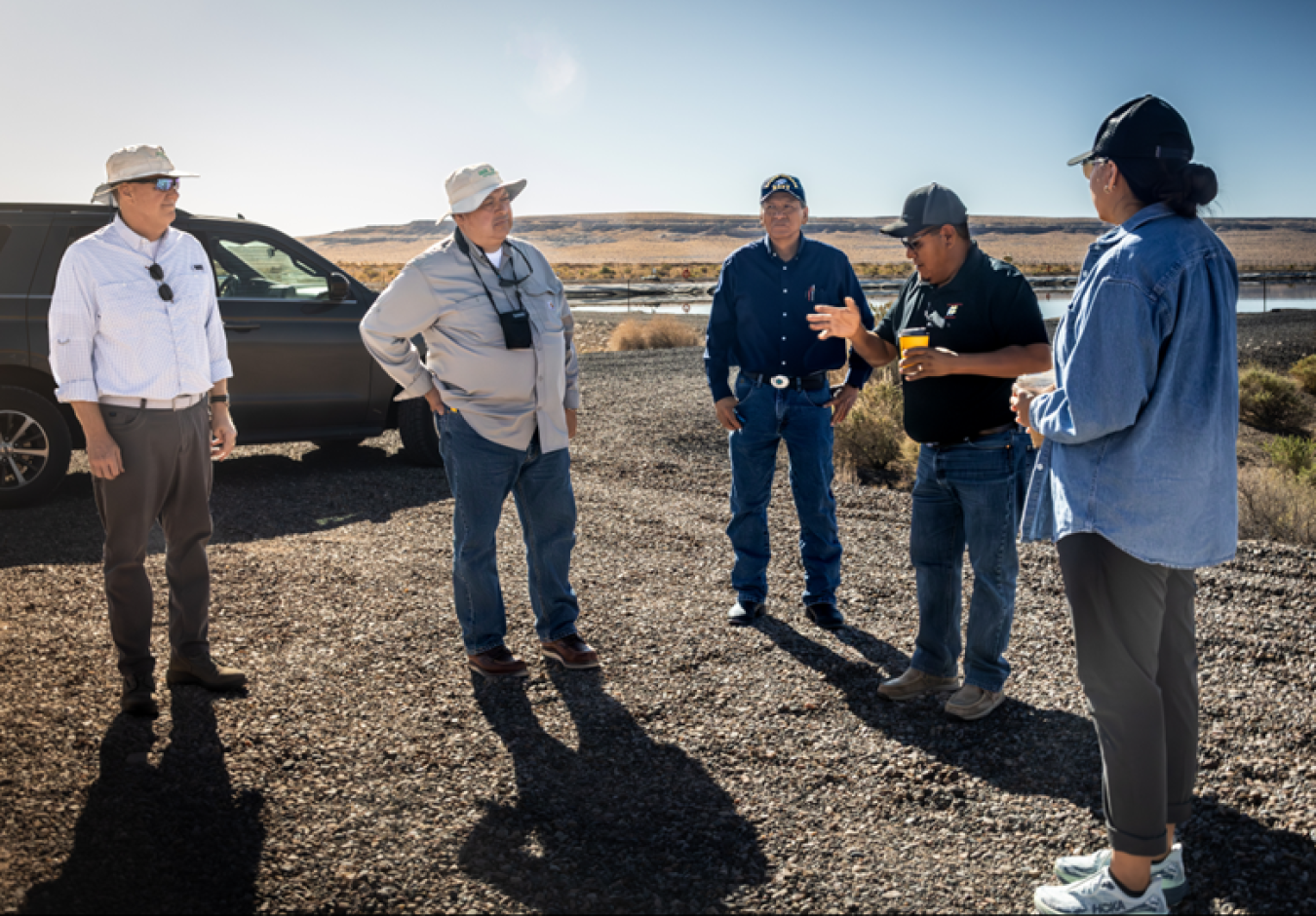New projects to ensure clean groundwater at LM’s sites in Tuba City, Arizona and Shiprock, New Mexico
November 20, 2025The Office of Legacy Management’s (LM) highest-ranking leaders recently visited two LM sites on the Navajo Nation to get updates on two major projects.
On Sept. 16-17, Chief of Staff Andrea Dolch, Director of Site Operations, Jay Glascock, and Director Carmelo Melendez toured the Tuba City Disposal Site in Arizona and the Shiprock Disposal Site in New Mexico. Project teams provided updates for the group on water-treatment units (WTU) that are planned at each site.
At both sites, tailings from uranium-milling operations are encapsulated in disposal cells and managed under the Uranium Mill Tailings Radiation Control Act (UMTRCA). Each site played a role in supplying uranium to the U.S. government during the Cold War. At each location, contaminated groundwater from historic milling operations is pumped to the existing lined-evaporation ponds, where it quickly evaporates in the dry environment.
LM’s Wil Burns, Bill Frazier, Hallie Katz, and Joni Tallbull joined LM leadership on the tour. Frazier is the Tuba City site manager and Tallbull is the Shiprock site manager.
Shiprock and Tuba City are two of the four disposal sites LM manages on the Navajo Nation. At Shiprock, a WTU is being built to replace the evaporation pond that has reached its end of life. At Tuba City, LM is conducting a comprehensive evaluation of the site’s groundwater remediation infrastructure to determine whether the existing wells, pipelines, and infiltration trenches can support a future upgraded treatment system.
Because of the scarcity of water in the region, the goal of both projects is to treat the water and release the majority of it back to the watershed rather than letting it evaporate in the ponds.
Frazier, a member of the Navajo Nation, led the group through an orientation of the Tuba City site, informing them of the history of Moenkopi Wash, which lies downgradient from the disposal cell on Hopi Tribal land.
“The Hopi Tribe has tremendous concern for the wash,” Frazier said. “The Hopi farms downstream at the Moenkopi Village have been there for over a thousand years.”
Water from the alluvial aquifer in Moenkopi Wash sustains the dry farming techniques the Hopi have used for centuries. Both the Navajo and Hopi tribes have asked LM to take every measure to ensure that contaminants of concern, such as uranium and nitrate, do not migrate from the site and into the wash.
Anthony Farinacci, groundwater manager for LM Support Partners, said the mission is to ensure groundwater conditions at the site stay in compliance with the Nuclear Regulatory Commission requirements.
Contamination from the former mill site has infiltrated the groundwater, Farinacci said. Uranium and nitrate are the two primary contaminants LM is monitoring, as LM works to limit the spread of the subsurface contamination plume at the Tuba City Disposal Site.
The need to conserve water is a driving force at the Shiprock site, and during the tour with LM leadership and the project team, Tallbull – a member of the Navajo Nation – said LM is responding to community input regarding the water in the evaporation pond.
“Residents have asked us about the evaporation pond. They ask, ‘Why are we letting that precious resource evaporate?’ So we took that earnestly,” she said.
When the project is done, the new WTU will treat water that is pumped from the site and surrounding areas. The treated water will then be released into the San Juan River or the surrounding wetlands, with oversight from U.S. Environmental Protection Agency Region 9.
The WTU’s solid waste will be tested to determine what contaminants and potential radionuclides are present before the waste is shipped to a licensed facility for permanent disposal.
The WTU will be operational as soon as summer 2026. The technology is a highly efficient, reliable industrial unit that the site team can monitor and operate remotely.
LM’s groundwater scientists will continue to monitor a contamination plume on the site floodplain while groundwater treatment continues. A revised Groundwater Compliance Action Plan is being developed for Shiprock to comply with federal standards.
“Out here in the high desert, we need every drop of water we can get,” Tallbull said. “This new treatment unit will allow us to recover at least 80 percent of the water that is extracted from areas that have been impacted by the formerly operated mill. The impact for the community will be huge.”




